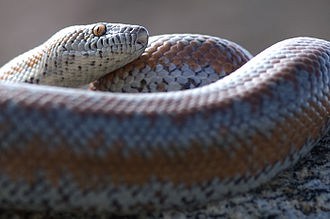Type the name of the breed you're looking for below
[wpdreams_ajaxsearchlite] Don't see the breed your're looking for? Click here and let us know!
Desert Rosy Boa
| Place of Origin and Range | Native species to western Arizona and extreme south eastern California. |
| Description | A stocky snake with a small head and a heavy slender tail. Prominent even-edged stripes of rose, reddish brown, or tan on a buff grey, bluish grey background. Sale of wild specimens is illegal. Captive-bred available. |
| Morph Patterns Available | Yes |
| Adult Size | Can grow 2-3 feet(0.6 - 0.9m) |
| Accommodation | Arid Rocky habitat. To avoid injuries anchor any rocks in the vivarium before you add the substrate. In this case sand. You will want to include a large dish for bathing and soaking in to improve shedding. Always include a day basking spot at 80'F(27'C). Along with multiple hides. Minimum 2 x 2 x 4 feet for an adult. |
| Lifespan | Can live 12+ years |
| Feeding / Diet | Like most snakes a this boa can eat mice, rats, and some newborns prefer lizards; depending on the size of your snake and the availability of feed. |
| Breeding | When you decide its time to breed. You will need a Male boa – at least 14-18 months of age, a Female boa – at least 3 years of age, and two large tanks or cages with a controllable heat source. You start by reducing the temperature and increasing the humidity from the regular climate in an attempt to trick the snake into thinking its time to mate. Only placing the male and female together for mating. Returning them to their respective habitats afterwards. After roughly 3-4 weeks of the cooling regime, we begin to introduce males into the female’s enclosure. Closely watching for signs of courtship from the male and reception from the female. Courting can sometimes happen immediately but can also take several weeks. During courting the male boa will be incessant in his actions, he will ‘scratch’ the females body with his spurs and be in constant contact with her. Once the female is receptive copulation will take place but is not always observed as it is often very difficult to see actual penetration of the hemipene. Once copulation is suspected, there are several tell-tale signs that indicate that the female is gravid. The first sign is an increase in girth; this is the females’ body getting ready for the actual event of ovulation. A gravid boa will usually refuse all feeding attempts, but it is still a good idea to offer a meal perhaps every 2 weeks but ensure that the food is significantly smaller than her usual meal. Once a female is gravid you may also notice a change in her behaviour, she will coil very tightly on the warm side of her enclosure and may in fact not move from this position for a number of days. Once a female has ovulated she enters a shed cycle, this cycle will happen about 15-20 days after ovulation, and this is the best indicator for when to expect your litter of boas. It is important to record all significant dates, such as ovulation and her post ovulation shed. The average time between her post ovulation shed and birth is 105 days. Rosy boas bear live young, about six in a brood, with newborns about 30 cm (12 in.) in length. |
| Other Considerations | Snakes are relatively hardy low maintenance animals when kept in the correct environment, and require little day to day care other than feeding and cleaning out the tank as required. However, like all animals, they can still become sick or injured despite our best intentions to prevent this. |



